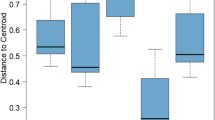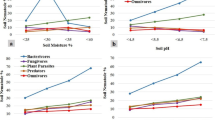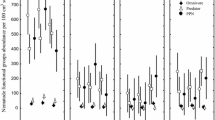Abstract
Technosol construction is an emergent technology that uses an assemblage of technogenic materials for the ecological reclamation of derelict land and waste recycling. Knowledge about the colonisation of Technosols by soil biota is limited, despite the latter’s central role in ecosystem functioning. In this four-year field (2008 to 2011) study, we characterized the development over time of the diversity and the abundance of soil nematodes in two types of Technosols in North-Eastern France. We also studied the nematode community structure, abundance of taxa and functional groups in both Technosol profiles in the third year of the study. Samples were collected from the top soil layer (0–20 cm) each year in the spring (April), on a one ha. field experiment that had spatially divided in 24 sampling areas. For soil profiles, three samples were collected in three horizons within six pits (three pits per Technosol). Nematodes were extracted from soil and identified at the family or genus level and then classified into functional feeding guilds. In the first year, the community was dominated by opportunistic bacterial feeders. The taxonomic and functional nematode diversity increased with time, with a dominance of non-opportunistic bacterial feeders after four years, but also the significant presence of fungal feeders, omnivorous and carnivorous, as well as plant parasites and insect parasites. No significant difference was observed between the two Technosols. Each layer showed distinct communities, with nematode diversity and abundance decreasing with depth. Abundance and diversity, coupled with the analysis of several indexes, commonly used for nematodes, including Maturity index (MI), Enrichment index (EI), Structure index (SI) and Nematode channel ratio (NCR), lead to the conclusion that the high organic matter content, particularly in the upper horizon of both Technosols, guaranteed nematode colonization and progressive diversification, and is likely to be the key for successful biodiversity reclamation.
Similar content being viewed by others
References
T. Bongers, De Nematofen van Nederland (KNNV Vereniging voor Veldbiologie, Utrecht, 1994).
T. Bongers, “The maturity index: an ecological measure of environmental disturbance based on nematode species composition,” Oecologia 83, 14–19 (1990).
T. Bongers and M. Bongers, “Functional diversity of nematodes,” Appl. Soil Ecol. 10, 239–251 (1998).
D. Bru, A. Sarr, and L. Philippot, “Relative abundances of proteobacterial membrane-bound and periplasmic nitrate reductases in selected environments,” Appl. Environ. Microbiol. 75, 5971–5974 (2007).
C. Chauvin, M. Dorel, C. Villenave, J. Roger-Estrade, L. Thuries, and J. M. Risède, “Biochemical characteristics of cover crop litter affect the soil food web, organic matter decomposition, and regulation of plantparasitic nematodes in a banana field soil,” Appl. Soil Ecol. 96, 131–140 (2015).
D. Cluzeau, M. Guernion, R. Chaussod, et al., “Integration of biodiversity in soil quality monitoring: baselines for microbial and soil fauna parameters for different land-use types,” Eur. J. Soil Biol. 49, 63–72 (2012).
Directive 2004/35/EC of the European Parliament and of the Council Establishing a Framework for the Protection of Soil and Amending (Commission of the European Community, Brussels, 2006).
S. Dray and A.-B. Dufour, “The ade4 package: implementing the duality diagram for ecologists,” J. Statistical Software 22, 1–20 (2007).
C. H. Ettema and T. Bongers, “Characterization of nematode colonization and succession in disturbed soil using the maturity index,” Biol. Fertil. Soils 16 (2), 79–85 (1993).
World Reference Base for Soil Resources 2014, International Soil Classification System for Naming Soils and Creating Legends for Soil Maps, Update 2015 (Food and Agriculture Organization, Rome, 2015).
H. Ferris, T. Bongers, and R. G. M. de Goede, “A framework for soil food web diagnostics: extension of the nematode faunal analysis concept,” Appl. Soil Ecol. 18, 13–29 (2001).
H. Ferris and M. M. Matute, “Structural and functional succession in the nematode fauna of a soil food web,” Appl. Soil Ecol. 23 (2), 93–110 (2003).
H. S. Gaur, “Dissemination and mode of survival of nematodes in dust storms,” Indian J. Nematol. 18, 94–98 (1988).
K. Goralczyk, “Nematodes in a coastal dune succession: indicators of soil properties?” Appl. Soil Ecol. 9 (1–3), 465–469 (1998).
F. Hafeez, F. Martin-Laurent, J. Béguet, D. Bru, J. Cortet, C. Schwartz, and L. Philippot, “Taxonomic and functional characterization of microbial communities in Technosols constructed for remediation of a contaminated industrial wasteland,” J. Soils Sediments 12 (9), 1396–1406 (2012).
F. Hafeez, A. Spor, M. C. Breuil, C. Schwartz, F. Martin-Laurent, and L. Philippot, “Distribution of bacteria and nitrogen-cycling microbial communities along constructed Technosol depth-profiles,” J. Hazard. Mater. 231–232, 88–97 (2012).
U. Irshad, C. Villenave, A. Brauman, and C. Plassard, “Grazing by nematodes on rhizosphere bacteria enhances nitrate and phosphorus availability to Pinus pinaster seedlings,” Soil Biol. Biochem. 43, 2121–2126 (2011).
ISO 10390:2005, Qualité du Sol—Détermination du pH (Organisation Internationale de Normalization, Geneva, 2005).
ISO 10693:1995: Qualité du Sol—Détermination de la Teneur en Carbonate—Méthode Volumétrique (Organisation Internationale de Normalization, Geneva, 1995).
ISO 11260:1994: Qualité du Sol—Détermination de la Capacité d'Échange Cationique Effective et du Taux de Saturation en Bases Échangeables à l’Aide d’Une Solution de Chlorure de Baryum (Organisation Internationale de Normalization, Geneva, 1994).
ISO 11261:1995: Qualité du Sol—Dosage de l’Azote Total—Méthode de Kjeldahl Modifiée (Organisation Internationale de Normalization, Geneva, 1995).
ISO 11263:1994: Qualité du Sol—Dosage du Phosphore— Dosage Spectrométrique du Phosphore Soluble dans Une Solution d’Hydrogénocarbonate de Sodium (Organisation Internationale de Normalization, Geneva, 1994).
ISO 23611-4:2007: Qualité du Sol—Prélèvement des Invertébrés du Sol—Partie 4: Prélèvement, Extraction et Identification des Nématodes du Sol (Organisation Internationale de Normalization, Geneva, 2007).
N. S. Jangorzo, F. Watteau, D. Hajos, and C. Schwartz, “Nondestructive monitoring of the effect of biological activity on the pedogenesis of a Technosol,” J. Soils Sediments 15 (8), 1705–1715 (2015).
N. S. Jangorzo, F. Watteau, and C. Schwartz, “Dynamic of the pore structure of constructed Technosols during early pedogenesis quantified by image analysis,” Geoderma 207–208, 180–192 (2013).
F. I. Kappers and M. L. P. van Esbroek, “Ecological recovery of decontaminated soil,” in Contaminated Soil 88, Ed. by W. J. van der Brink and F. J. Colon (Kluwer, Dordrecht, 1988), pp. 849–851.
C. Lefort, PhD Thesis (Institut National Polytechnique de Lorraine, Nancy, 2009).
J. L. Morel, C. Chenu, and K. Lorenz, “Ecosystem services provided by soils of urban, industrial, traffic, mining, and military areas, SUITMAs,” J. Soils Sediments 15 (8), 1659–1666 (2015).
D. R. Nemergut, C. C. Cleveland, W. R. Wieder, C. L. Washenberger, and A. R. Townsend, “Plot-scale manipulations of organic matter inputs to soils correlate with shifts in microbial community composition in a lowland tropical rain forest,” Soil Biol. Biochem. 42, 2153–2160 (2010).
C. C. Orr and O. H. Newton, “Distribution of nematodes by wind,” Plant Dis. Rep. 55, 61–63 (1971).
W. Ou, W. Liang, Y. Jiang, Q. Li, and D. Wen, “Vertical distribution of soil nematodes under different land use types in an aquic brown soil,” Pedobiologia 49 (2), 139–148 (2005).
F. Pan, N. Li, W. Zou, X. Han, and N. B. McLaughlin, “Soil nematode community structure and metabolic footprint in the early pedogenesis of a Mollisol,” Eur. J. Soil Biol. 77, 17–25 (2016).
B. Pey, J. Cortet, F. Watteau, K. Cheynier, and C. Schwartz, “Structure of earthworm burrows related to organic matter of a constructed technosol,” Geoderma 202–203, 103–111 (2013).
K. Ritz and D. L. Trudgill, “Utility of nematode community analysis as an integrated measure of the functional state of soils: perspectives and challenges,” Plant Soil 212, 1–11 (1999).
G. Séré, C. Schwartz, S. Ouvrard, J. C. Renat, F. Watteau, G. Villemin, and J. L. Morel, “Early pedogenic evolution of constructed Technosol,” J. Soils Sediments 10, 1246–1254 (2010).
G. Séré, C. Schwartz, S. Ouvrard, C. Sauvage, J. C. Renat, and J. L. Morel, “Soil construction: the first step of ecological reclamation of derelict lands,” J. Soils Sediments 8 (2), 130–136 (2008).
M. Viketoft, B. Sohlenius, S. Boström, C. Palmborg, J. Bengtsson, M. P. Berg, and K. Huss-Danell, “Temporal dynamics of soil nematode communities in a grassland plant diversity experiment,” Soil Biol. Biochem. 43 (5), 1063–1070 (2011).
C. Villenave, T. Bongers, K. Ekschmitt, D. Djigal, and J. L. Chotte, “Changes in nematode communities following cultivation of soils after fallow periods of different length,” Appl. Soil Ecol. 17, 43–52 (2001).
C. Villenave, D. Djigal, A. Brauman, and C. Rouland-Lefevre, “Nematodes, indicators of the origin of the soil used by termites to construct biostructures,” Pedobiologia 52, 301–307 (2009).
L. Wasilewska, “Changes in the proportions of groups of bacterivorous soil nematodes with different life strategies in relation to environmental conditions,” Appl. Soil Ecol. 9 (1–3), 215–220 (1998).
L. Wasilewska, “Differences in development of soil nematode communities in single-and multi-species grass experimental treatments,” Appl. Soil Ecol. 2 (1), 53–64 (1995).
G. W. Yeates III, “Vertical distribution at eleven sites,” N. Z. J. Agric. Res. 23 (1), 117–128 (1980).
G. W. Yeates, “Nematodes as soil indicators: functional and biodiversity aspects,” Biol. Fertil. Soils 37, 199–210 (2003).
G. W. Yeates, T. Bongers, R. G. M. de Goede, D. W. Freckman, and S. S. Georgieva, “Feeding habits in soil nematode families and genera—an outline for soil ecologists,” J. Nematol. 25 (3), 315–331 (1993).
X. K. Zhang, Q. Li, A. N. Zhu, W. J. Liang, J. B. Zhang, and Y. Steinberger, “Effects of tillage and residue management on soil nematode communities in North China,” Ecol. Indic. 13, 75–81 (2012).
Author information
Authors and Affiliations
Corresponding author
Additional information
Published in Russian in Pochvovedenie, 2018, No. 10, pp. 1274–1282.
Materials of the 9th Congress “Soils of Urban, Industrial, Traffic, Mining and Military Areas, SUITMA”. Supplementary materials are available for this article at 10.1134/S1064229318100149 and are accessible for authorized users.
Electronic supplementary material
Rights and permissions
About this article
Cite this article
Villenave, C., Séré, G., Schwartz, C. et al. Rapid Changes in Soil Nematodes in the First Years after Technosol Construction for the Remediation of an Industrial Wasteland. Eurasian Soil Sc. 51, 1266–1273 (2018). https://doi.org/10.1134/S1064229318100149
Received:
Published:
Issue Date:
DOI: https://doi.org/10.1134/S1064229318100149




